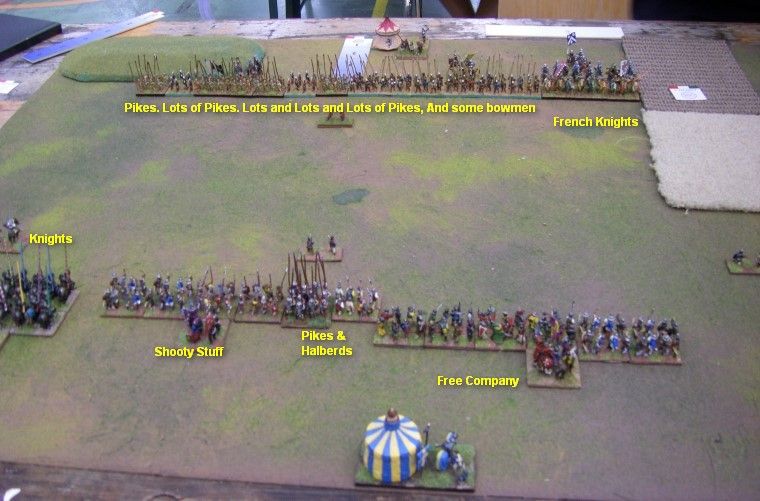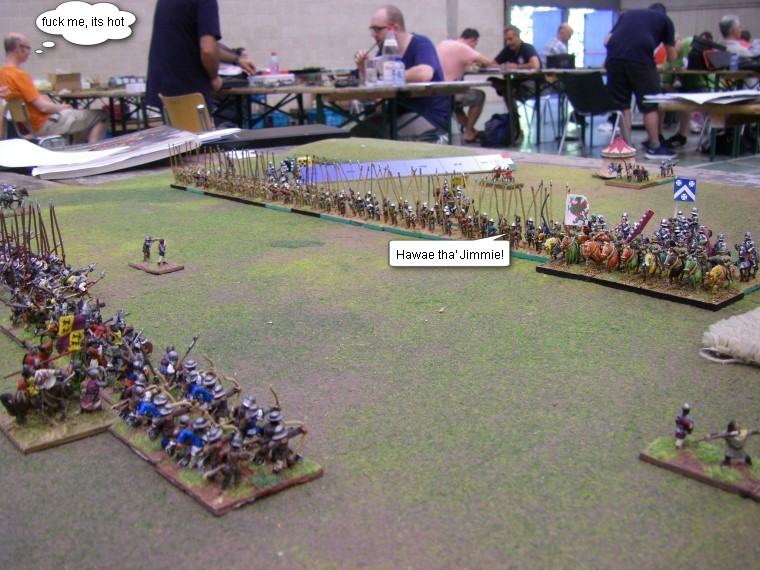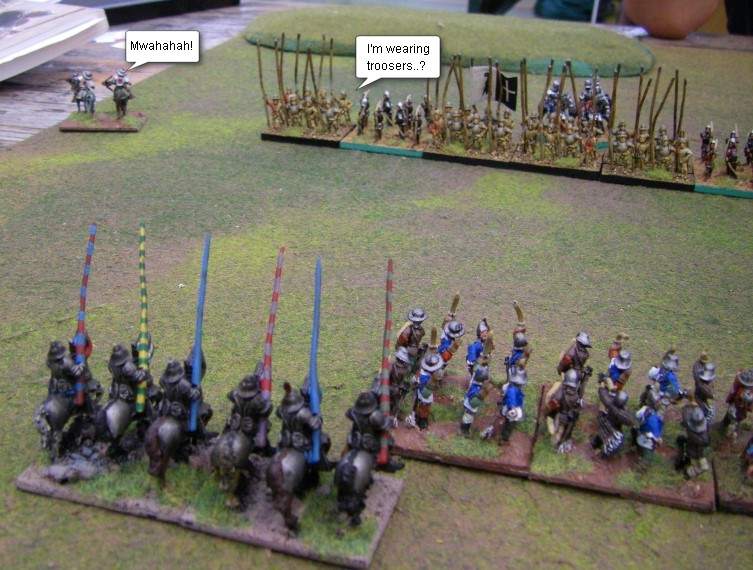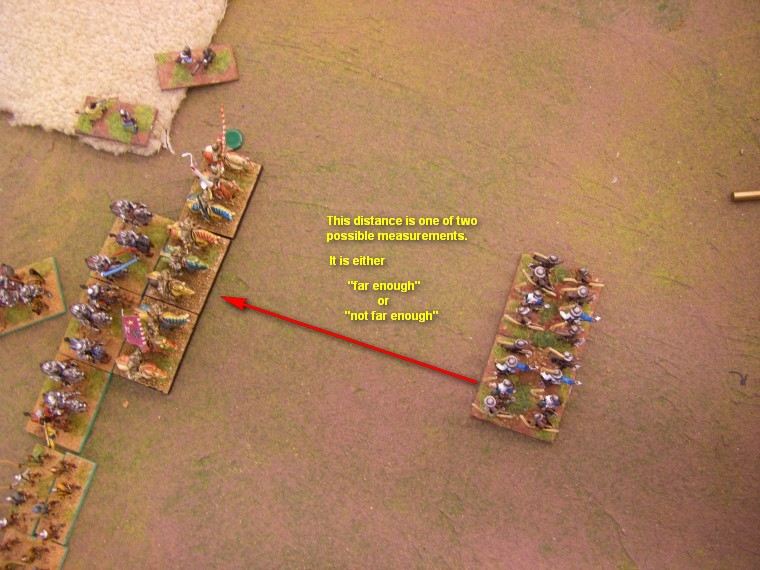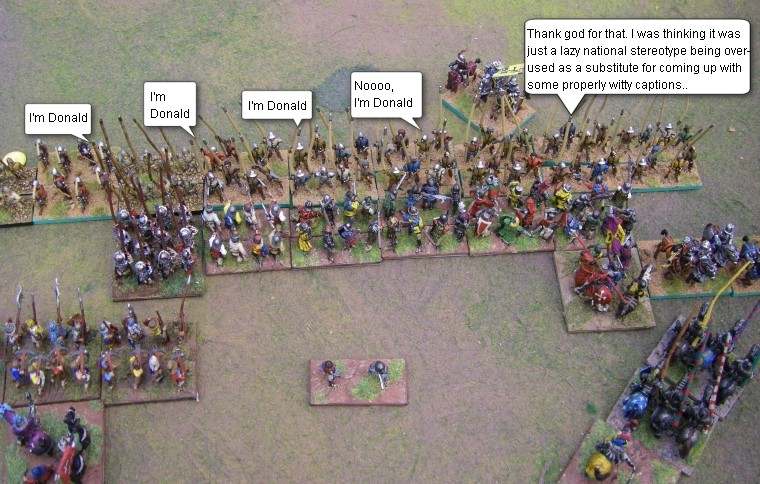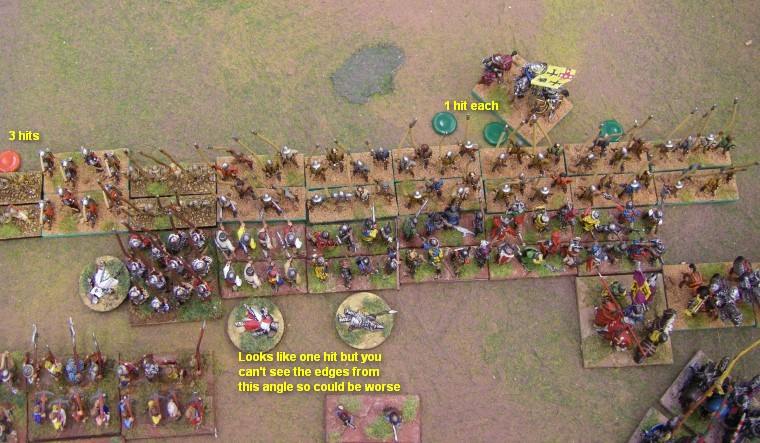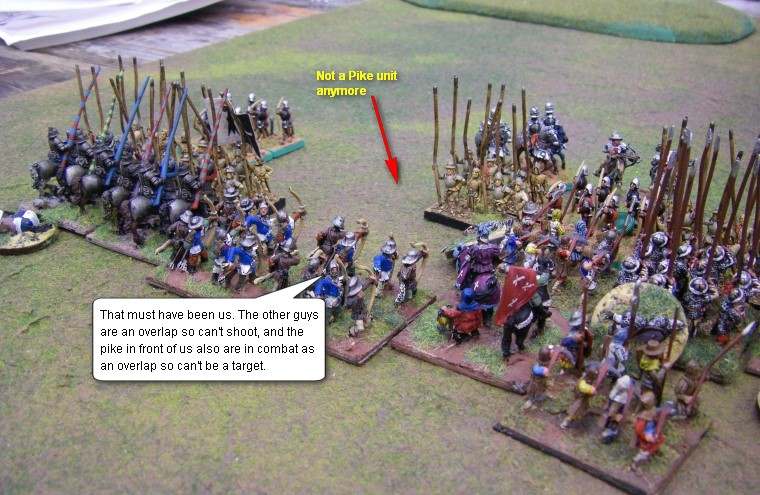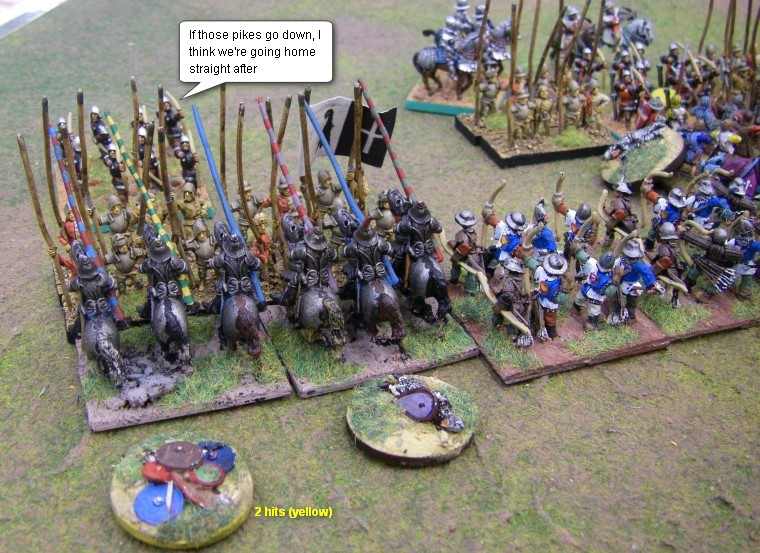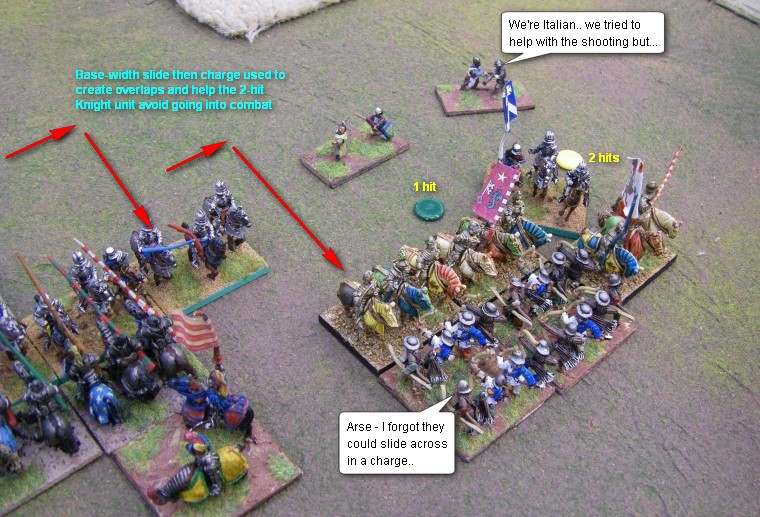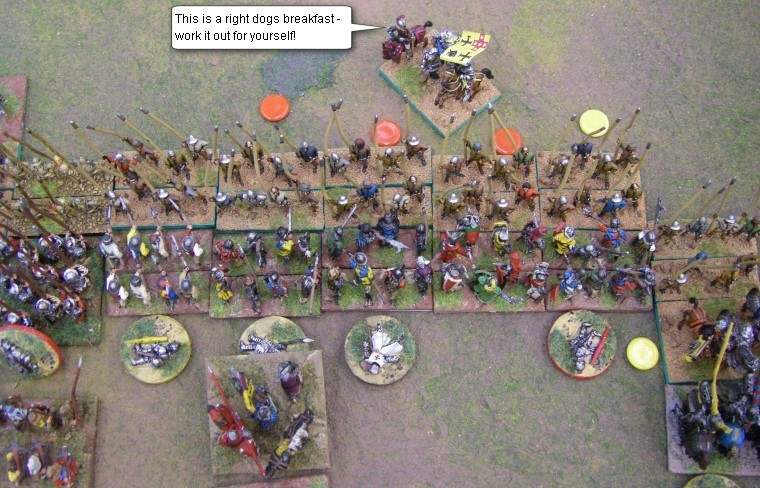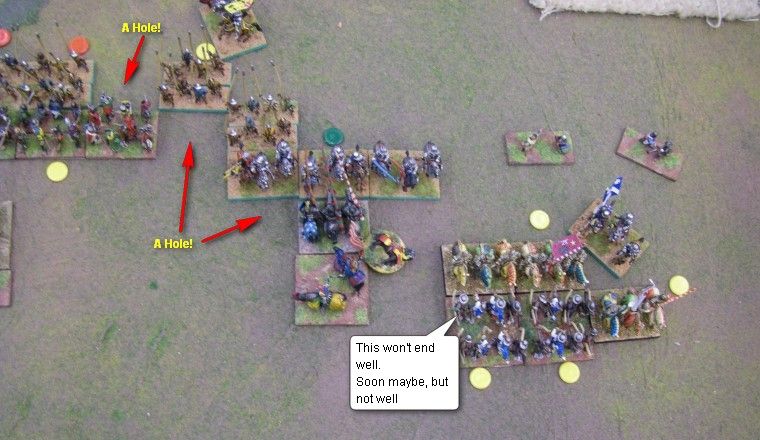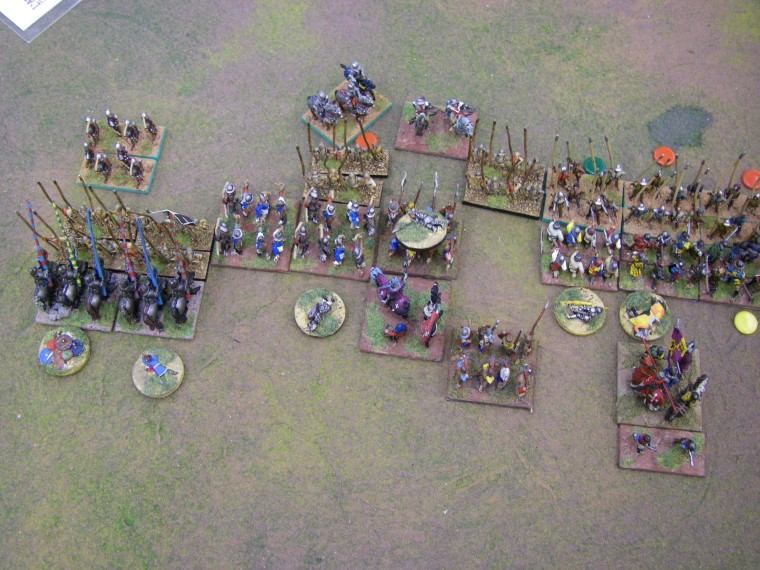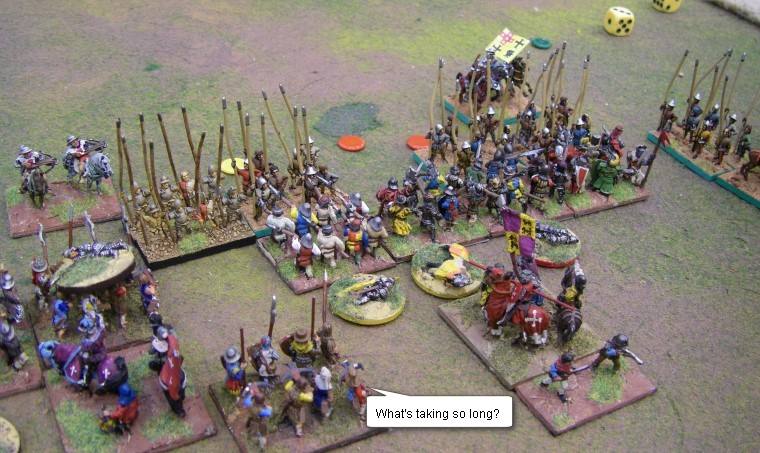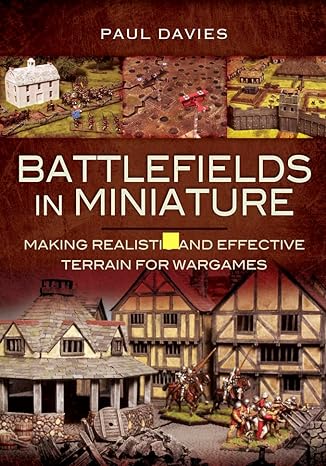The Worlds in Charleroi 2016
Italian Condotta - Florence vs Medieval Scots
Game 1 Italian Condotta - Florence vs Condotta Italian
Game 2 Italian Condotta - Florence vs Medieval Scots
Game 3 Italian Condotta - Florence vs Han Chinese
Game 4 Italian Condotta - Florence vs Late Roman
Game 5 Italian Condotta - Florence vs Seleukid
Game 6 Italian Condotta - Florence vs Italian Condotta - Venice
With the first game ending in a painful - and for much of it, clearly inevitable - defeat in which my small army had been forced into a unit-trading exercise with a mirror image edition of itself which was inherently more capable of surviving exactly such a scenario, the second game offered a shot at redemption, tempered with a nagging suspicion that the makeup of my force was not as good as it needed to be in this beltingly hot crucible of combat.
Or, put another way, I had worked out that other people, from other countries, playing more games than I had, were probably going to be better than me. And it was also bloody hot - Charleroi's industry may have been long gone, but the memory of the blast furnace lived on in 35+ Centigrade temperature which the non-air-conditioned sports hall we were playing in, with its cunning "pizza pven" design was perfectly formatted to maximise.
The second game saw the brave, but already rather concerned they might be futile, forces of Florence taking the magic roundabout of combat deep into the medieval era once again, facing a textbook Medieval Scots army. The lists for the Italian Condotta - Florence and Medieval Scots from this game, as well as all the other lists from the games at Charleroi can be seen here in the L'Art de la Guerre Wiki.
The Scots are the army of Flodden and other such defeats, and are an unimaginative mix of inferior pikemen bulked out with an almost mandatory French contingent of high quality knights. Wide, deep (if you field the 3 ranks of pikemen or can squeeze more on a base than that) but brittle they will create a simple but effective tactical problem for any opponent.
I had set out my stall on as wide and featureless a plain as possible, knowing the Scots would have a wall of pikemen to throw across the table at me. The Halberdiers of the Free Company should be highly effective against Inferior Pike, so they sat this time facing a place where I expected the Scots to be anchoring their pikemen on a piece of terrain, with the longbows and then Knights extendinig the battleline to the left, hoping to find space to wrap around the inevitably open flank and cause trouble.
The Scots however failed to comply with my plan, and squeezed their French knights into the space next to the terrain. This gave a problem to the Free Company, as they now faced the only units on table they were reluctant to fight, but did give the Italian knights some hope that the undefended open flank of the other end of the Scots line would be something they could exploit before the crab-like advance of the wall-o-pikes could close the door by sliding across to their right
But, considering the overall situation, the risk to Hawksmoor's men - in theory my battle-winners - from the French knights looked far worse than the opportunity of sneaking some mounted nobles past the Scots on the other wing - where my ability to support them with the Crossbow/Longbow command was in any case rather limited. The Knights, thinking back to the successes of the Aechemenids in France earlier this year, decided to be bold, imaginative and redeplyed a couple of units to help Hawksmoor hold up his flank.
Scots Pikemen
The Italian mounted crossbows were far too fast for the pedestrian Scots, and straight away a group of LH were round the end of the line. The pikemen had to make a decision - ignore the interlopers, or spend time and pips trying to pin them down, at the expense of thinning their line and slowing their forward momentum..
L'Art de la Guerre hint - If a Pike Block turns, the turn eats up all of their movement for that action. Most other units can turn and still make some sort of forward move.
The redeployment of the Knights had just about worked - Hawksmoor and his men were now racing forwards and sliding as they went - throwing themselves towards a locked-in line of combat against the Scots centre whilst hoping that the half-hearted force of Florentine knights arriving to their right would be able to hold off the French for long enough to let the Free Company men chew through the Scots. On the left the longbowmen and crossbowmen were far less keen to get into combat, being far happier trying to shoot down the Scots to damage them before combat took place.
L'Art de la Guerre hint - Pike vs Longbowmen would be +2 to the pikes here, with the Poor Pikemen deducting 1 from any roll of 4,5 or 6, and the Elite Longbows adding 1 to any rolls of 1,2 or 3. One hit on the Pikemen makes the base factor +1 to the pikes - much better odds.
Two longbowmen from Hawksmoors command had been left behind in the infantry's sidewards slide - quite deliberately - and they now found themselves tasked with helping the incoming Italian knights with holding off the French charge. Carefully staying at distance to maximise the number of shots they would get, the bowmen loosed off a series of volleys, their survival dependent on their accuracy and effect.
What's Going on Here Then?
The Scots have set up with a high quality General commanding 2 blocks of Pikemen in the middle, and good first pips have allowed him - unsurprisingly - to move a vast line of pikemen forwards pinning the Florentines back on their start line. The unexpected deployment of the French Knights has also caused problems, but most significant is the sheer width and speed of advance of the Scots. The Free Company are better by far man on man, but they are inevitably overlapped at both ends of their line. Like in the first game, the shooters in the Florentine army are more a liabiilty than an asset as the deplyment of the largest block of them misjudged where the Scots would place their mounted, and so now the prospect of bows fighting proper infantry - and losing swiftly - is very real. A tactical problem for the Florentines which they have very little time to solve.
The firing may have been accurate, but the French knights were shrugging off the incoming fire with disdain, taking no hits as they bore down on the bowmen. But, at least Hawksmoor and his men were now completely in combat against the potentially skittle-like Scots pikes. The holding job asked of the Italian knights and English longbows on this flank looked a folorn hope, but if they could at least buy some time Hawksmoor and his men could be straight through the Scots and on their way to the highlanders baggage before their flanks began to be rolled up.
Scots Pikemen
The line of combat was as solid as if Phil Barker himself had designed it, only the slightly cheapskate use of 2 bases depth by the Scots to represent 3 putting a small amount of deglossing to the martial spectacle.
L'Art de la Guerre hint - Pike vs Halberdiers would be +1 to the pikes initially, with the Poor Pikemnen again deducting 1 from any roll of 4,5 or 6. The halberdiers however win all ties (in combats between Halberds and Pikes & Spears), and also add +1 to any winning final score (meaning that each time they win a round of combat there is a 50/50 chance of doing an extra level of damage on the enemy. As soon as the Pikemen units take a hit, the basic factor drops to evens, giving the Halberdiers a decisive overall advantage once Quality and the weapon and interaction factors come into play.
The first round of push and shove was indecisive, with 3 markers on both sides - not too bad an exchange for the Free Company men against the wider (and hence overlapping) line of Pikemen.
The combat developed as the two lines of men, separated by hundreds of miles of continental Europe and the North Sea but united in their simultaneous love and fear of the rigors of close quarters combat and a shared history of fighting as single 15mm x 40mm bases in previous rulesets continued to push and shove. The Scots were taking more of a hammering on the right, where 2- and even 3-hit markers had started to appear, threatening breakthroughs for the Free Company men, whilst on the left the Pavisers had joined the action to shore up the overlapped end of the Italian line.
Medieval Combat
The English longbow on the left flank had been incredibly effective, shooting down whole files of Pikemen and creating large holes in the enemy army...whether Rangers of Celtic supporters, all of the Scots died the same to the power of the longbow. But the plan to infiltrate knights round their flank had come unstuck as the Knights commander had been forced to spend all of his pips moving the other part of the knightly force over to face off the French - leaving these elements rather becalmed and out of command and control range, unable to do anything other than stand and take a charge from the onrushing Scots.
The Italian knights needed to survive the initial Scots attack, after which their heavy armour would hopefully allow them to hang on whist the Longbows moved up to nibble away at a flank. But the Pikemen knew an opportunity when they saw it, and fortifying themselves with deep fried Mars bars they charged home and inflicted serious 2-hit and 1-hit damage on the Knights
Pictures of Medieval Pikemen in 15mm from my Ancients Photo Directory
The other English contingent was far less happy - in close quarters combat against the French, the Light Medium Foot in the Open hit by Knights were plumbing the depths of what scale of difference in base factors it would be possible to achieve in ADLG....
What's Going on Here Then?
The Free Company are making heavy going of beating the supposedly weak Scots pikemen in the centre, and the attempt to outflank the Scots on the left has also been prevented by the sheer speed of the Scots advance and width of their line. On the right of the Florentine line the French Knights faced little opposition as the rest of their Hibernian allies occupied the full attention of the Florentine army and now they are fast closing on the mercenary Longbowmen. If this were American Football, it would be a Blitz play by the Scots, and the Florentine quarterback would be pretty dammned close to making a fumble at this precise point in time
The centre of the Scots line was now teetering dangerously, with a wall of 3-hit red markers spread across their backline. Kilt-makers across the Highlands and Lowlands were wondering whether to change their business models to include tartan grave shrouds in their products lines as the Free Company men scented victory - even as they themselves were suffering a number of cohesion losses of their own.
The victory, if it were to be achieved by the Free Company men, would have to come soon. The right flank was now only a handful of seemingly inevitable hits away from being entirely free of Italian troops with the Longbowmen on their last arrows, and the sole remaining Italian knight injured and double-overlapped.
The thinning Scots line on the left was, infuriatingly, holding up well as the Scots reached deep into their sporrans for reserves of fortitude and resilience, preventing the seemingly overwhelming number of Italians from taking full advantage of their additional numbers.
The Italian right flank was however now entirely gone. Only the decision to make the General non-embedded was keeping the Italians from utter despair as the ice-cream of their military prowess sagged and melted under the hairdryer force of French heat.
What's Going on Here Then?
Overwhelmed by the French Knights, the thinned out right hand end of the Florentine line has been crushed, and the Scots are now rolling up the Free Company from the right. Stoic defence by the Scots pikemen, aided by a good-quality General making some crucial rallying rolls to keep the pikemen aliive whilst the French did their worst has meant that the losses are stacking up far faster on the Italian side than on the Scots. On the left the Florentine knights have gotten bogged down in yet more attritional combat against poor quality but 4-hits-to-kill pikemen and are not making headway anywhere near fast enough. Defeat is imminent
In the centre, Hawkswood's men were time and time again coming up just short of the decisive breakthrough which they had threatened for so long - the more numerous Scots were in fact the ones holding on for a famous victory, as the collapse of the Italian right flank, and the steady attrition of the rest of the army in the course of forcing a victory against a dour and stoic opponent cost them dear again.
The Result is another defeat
Click here for the report of the next game in this competition, or read on for the post match summaries from the Generals involved, as well as another episode of legendary expert analysis from Hannibal
Post Match Summary from the Italian Condotta - Florence Commander
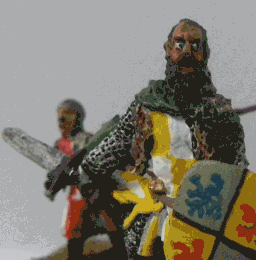 Never mind the quality, feel the width is what my tailor says when he is trying to palm me off with some sort of knock-off roll of embroidered cloth he has managed to pick up after it has no doubt fallen off the back of an ox-cart somewhere on the track between Milan and Padova, and this is exactly how I feel looking back at this game.
Never mind the quality, feel the width is what my tailor says when he is trying to palm me off with some sort of knock-off roll of embroidered cloth he has managed to pick up after it has no doubt fallen off the back of an ox-cart somewhere on the track between Milan and Padova, and this is exactly how I feel looking back at this game.
My army was in theory well equipped to deal with a wall of inferior pikes, as the Free Company were born for the work of hacking down sub-standard pedestrians armed only with pointy sticks - but whilst they did their grisly work the rest of the Scots army was 'oop and under' and then right over the top of my men before I could finish my first coffee of the day.
Having seen my Persian predecessor surmount such an obstacle in Saumur earlier this summer perhaps I should have been more imaginative with my deployment, but with such a perfect matchup for large swathes of my infantry it seemed like this would be a game for the taking with a frontal assault and some knights round the side, but the speed of the enemy advance and they crab-like inching forwards and sideways managed to close down the flank most effectively and left my Noblemen with nothing creative left to do,
There is much to learn here about the fine balance of quality vs quantity in these rules - always an easier mechanic and outcome to achieve in a DBx-based set I feel, where there are very many separate units all of whom need to be beaten in combat, unlike a unit-based set where the advantage of numbers can struggle to be brought to bear in a constructive sense on a FoG-like tabletop where all armies put forth maybe 12-16 units and there is little scope for flanks and little advantage in taking on one good unit with 2 poor ones. Numbers counted in DBM, and in ADLG, where attrition also plays a part in grinding down even the victorious units to reduce their capability after prolonged combat, that balance may be even more finely tuned.
Hannibal's Post Match Analysis
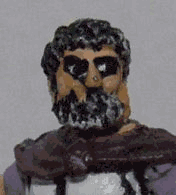 How simple was it for you to fall to defeat here? A plan which you had seen not once but twice before in Saumur, which you has ostensibly been able to work out and counter already, but which here unhorsed you and your army of incompetent fools and halfwits in barely an hour and a half of game time! Only someone as befuddled as you could make such a mistake twice- so far....
How simple was it for you to fall to defeat here? A plan which you had seen not once but twice before in Saumur, which you has ostensibly been able to work out and counter already, but which here unhorsed you and your army of incompetent fools and halfwits in barely an hour and a half of game time! Only someone as befuddled as you could make such a mistake twice- so far....
Once the enemy had won the initiative roll....which, your idiot choice to drop that 2nd LH from your Devizes list and so forgo an extra scouting point for having 2 LH contributed greatly to, the next moves were utterly obvious, yet you willingly threw your admittedly in theory better, but certainly less wide, infantry at by deploying up on the full extent of your deployment zone.
When the enemy rushed forward, wider than you, you had no choice but to commit not only your good troops but also your bad ones at the same time....and your weak troops take but 3 hits and your good ones were fighting pikemen who can take 4. Well, shake a fools stick at an angry bear and you will not be surprised by the result, and so it proved here as your 3-hit guys lost faster than the enemys 4-hit troops and thus the battle was lost!
Many things are not your strong point, and to that list we can add again "deployment" and that old favourite, "basic maths". Whilst I am delighted to see that ADLG supports and makes entirely viable such a wide range of armies and tactics so as to make medieval Scots an interesting choice, I fear even more for your overall outcome this competition. Let's see what idiocy you can add to this list of errors and failings in the next game
Click here for the report of the next game in this competition
You can also comment, "like" or give feedback on these reports on either the Madaxeman.com Facebook Page or the Madaxeman.com Blogger Site.
Game 1 Italian Condotta - Florence vs Condotta Italian
Game 2 Italian Condotta - Florence vs Medieval Scots
Game 3 Italian Condotta - Florence vs Han Chinese
Game 4 Italian Condotta - Florence vs Late Roman
Game 5 Italian Condotta - Florence vs Seleukid
Game 6 Italian Condotta - Florence vs Italian Condotta - Venice
View My Stats for My Match Reports Pages



